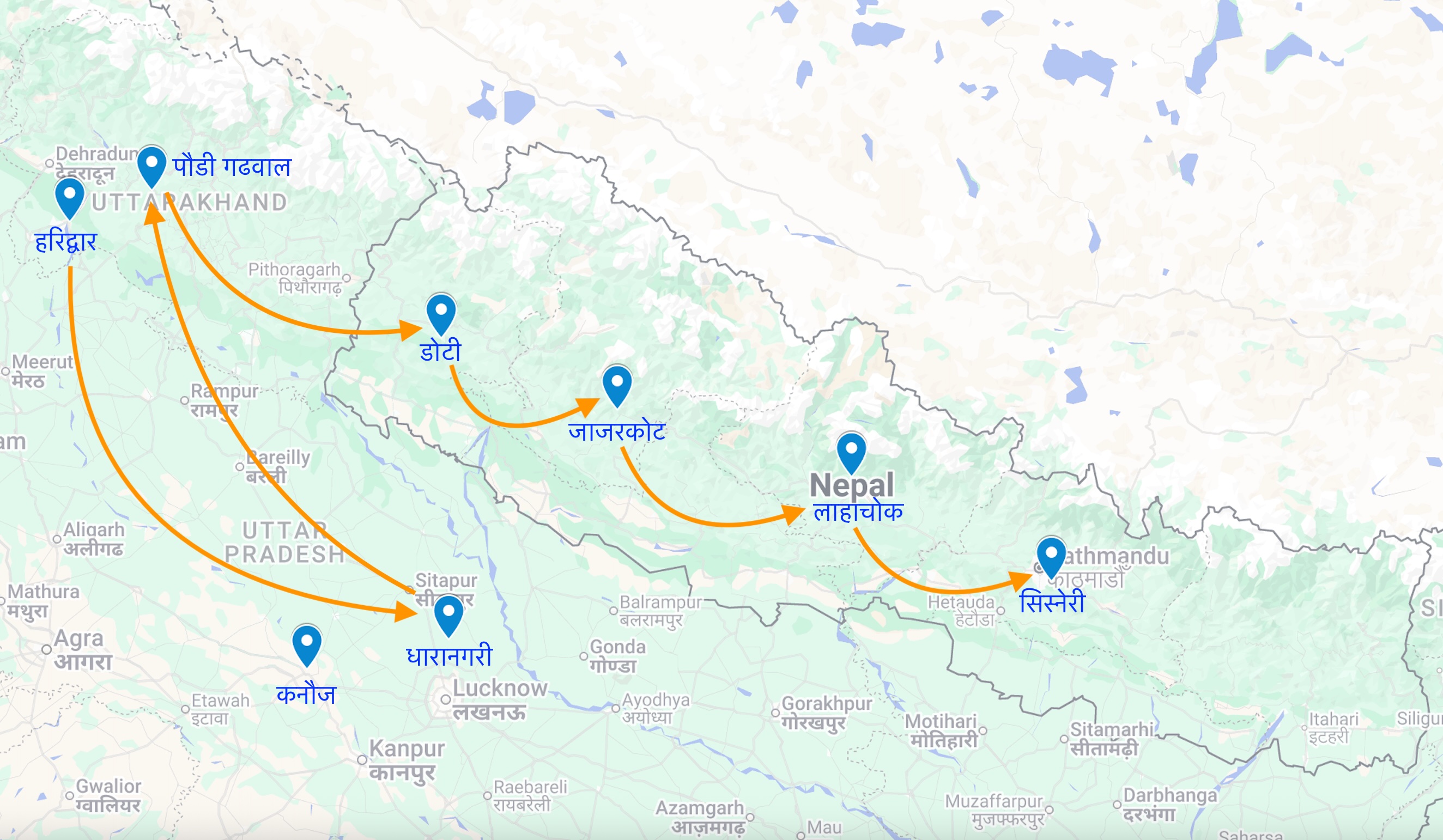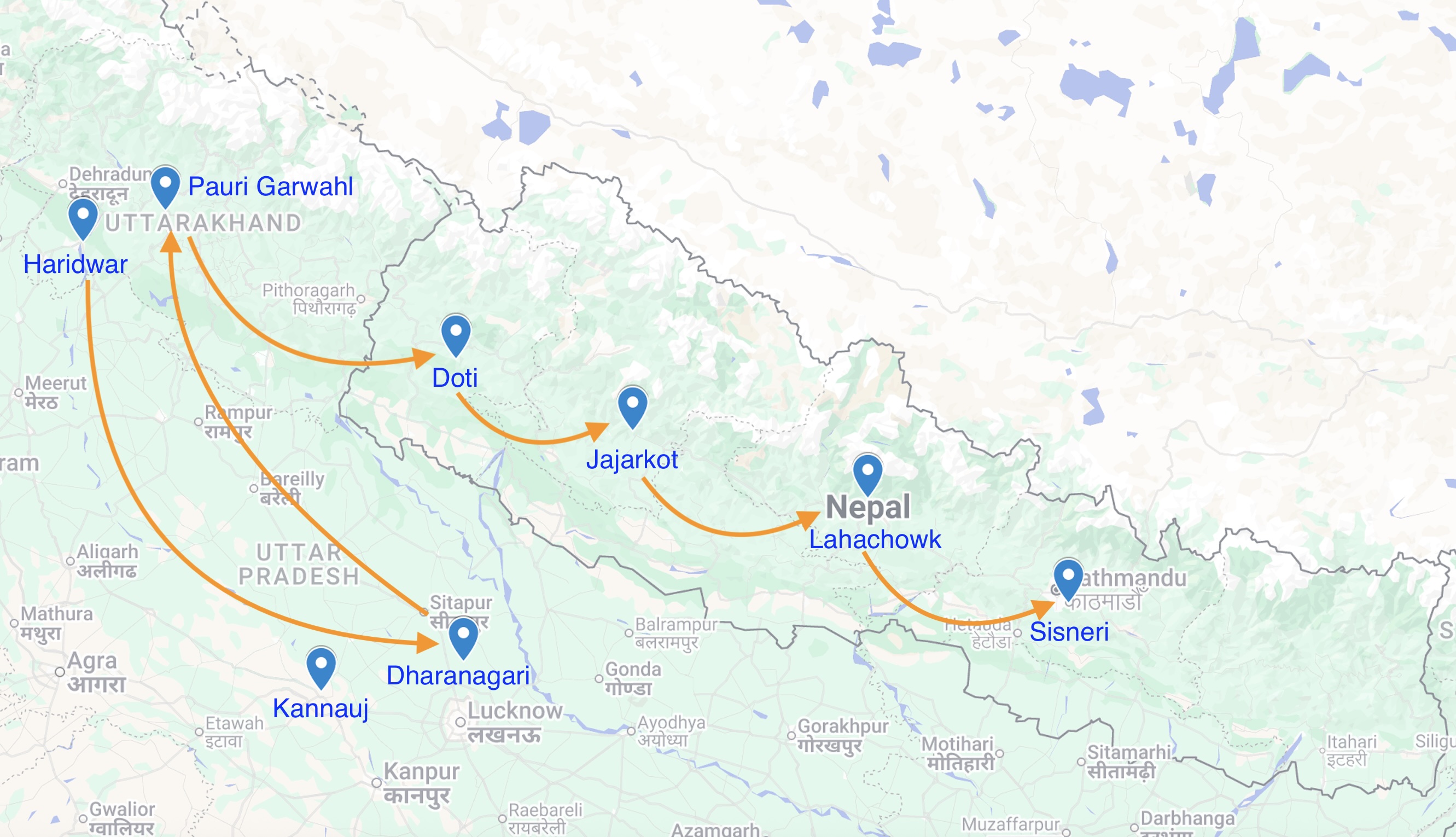अवलोकन
‘पौडेल/पौड्याल’ (अंग्रेजीमा Paudel, Poudel, Paudyal, Poudyal) नेपालका सबैभन्दा ठूलो संख्यामा रहेका नेपाली थरहरू मध्ये एक हो। पौडेलहरुले चौबीसै खस गणराज्यका राजगुरु, पण्डित, सैनिक आदि पदहरू सम्हालेका थिए।
उत्पत्ति र नाम
पौडेल हुनुभन्दा पहिला हामी सबै 'भट्ट' थियौं। बाह्रौं शताब्दी वा त्यसपछि मात्र श्रीवत्सराजको सन्तान श्रीदेवबाट 'पौडेल' भएका हौं। श्रीवत्सराज 'पौडी गढवाल' निवासी भएकाले यिनको वंश – पौडी+ आलय = पौडयालय कहलिन थाल्यो। कालान्तरमा पौडयालयबाट अपभ्रंश भएर पौडयाल र पौडेल थरको विकास भएको पाइन्छ। नेपालमा बसाइँसराइ चाहिं पछि सम्भवतः दिल्लीका सुल्तान अल्लाउदिन खिजलीका समयमा तेह्रौँ शताब्दीमा मात्र नन्दराम भट्ट वा कृष्णरामका पालामा "गढ़वाल पौडी"बाट डोटीको पौडीमा आएर बसेको भन्ने पनि पाइन्छ। नयाँ ठाउँ (हाल नेपाल) को नाम पनि आफ्ना पुरानो ठाउँ (पौडी गढवाल)का नामबाट पौडी राखे अथवा कुमाउ र सिञ्जाली भाषामा शब्द मिल्न गएर दुवैतर्फ पौडी भन्ने स्थान रहन गएको थियो यसै भन्न सकिन्न।
बसाइँसराइ र सिस्नेरी बसोबास
यसरी पौडी गढवालबाट आएर डोटी, जुम्ला, जाजारकोट खस क्षेत्र, लाहाचोक हुँदै विभिन्न स्थानहरूमा पौडेलहरु बसोबास गर्दै आएको भनाइ छ। पछिल्लो समयमा बसाइँ सर्ने क्रममा सिस्नेरीका पौडेलहरू लम्जुङको दुराडाँडाबाट आएका हुन् भन्ने पनि कतैकतै उल्लेख पाइन्छ।
यसरी बसाइँ सर्दै आएका पौडेलहरू ललितपुर जिल्लाको लामाटार, सिस्नेरीमा आएर बसोबास गरे। सिस्नेरीका मूलपूर्खा गोपालले पुत्रेष्टि यज्ञ गराएर पुत्र जन्मेवापत राजा सिद्धिनरसिंह मल्लबाट विर्ता पाई सिस्नेरीमा बसोबास गर्नुभएको जनश्रुति छ। युवराज श्रीनिवासको वि.सं. १६८४ मा जन्म भएअनुसार शायद यो वि.सं. १६८० दशकको कुरा हुनुपर्छ।

कुलपूजा परम्परा
गोपालका सन्ततिहरुले बि सं १७३४ सालदेखि नै सिस्नेरीमा देववली(देवाली) गर्दै पनि आएका छन्। यहाँ आएका पौडेलहरू पछि छरिएर कोहि धापाखेल, मकवानपुर नजिकको टेकर सिस्नेरी, चावहिल, वानेश्वर, कोटेश्वर, ललितपुरको चसिडोल, लामाटार, ठूलाघर, दोलखा, काभ्रेमा पनि वसाइ सरेको देखिन्छ। यी पौडेलहरूले लुकदेवताको पूजा र देवाली पनि यही लामाटार सिस्नेरीमा गर्ने गर्दछन्।
लामाटारमा बसोबास गर्ने पौडेलहरूको एकवर्ष बिराएर देवाली गर्ने प्रचलन रहेको छ। यस वर्ष २०८२ सालमा दुवै पर्व परेको छ। देवाली (देववली) हुने वर्ष भन्दा करीब ४ महिना पहिले भाद्र महिनामा लुकदेवताको पूजा गर्ने प्रचलन रहेको छ। यसमा धापाखेलका पौडेल पुरेत र चसिडोलका पौडेल यजमान वनेर श्राद्ध र हवन पनि गर्ने गरिन्छ। सिस्नेरीको बैसेरी नजिक रहेको स्थानमा चारसय वर्ष पुरानो खरिको रूख मुनी मस्टो स्थापना गरी श्राद्ध, पूजा तथा हवन गर्ने प्रचलन रहेको छ। मस्टोलाइ कसैले पनि हेर्न नहुने भएकोले लुकाएर ल्याएर पूजा गर्ने र पूजा सकिएपछि फेरी लुकाएर ट्यांकामा नै राखी लैजाने परम्परा रहेको छ। यसरी लुकाएर पूजा गर्ने परम्परा भएकोले यसलाई लुकदेवताको पूजा पनि भन्ने गरिन्छ। यो पर्वको रमाइलो पक्ष भनेको यहाँ चढाएका कुनैपनि कुरो घरमा लगेमा अशुभ हुन्छ भन्ने प्रचलन रहेको छ। त्यसैले ल्याएका सवै कुरो त्यही सकेर जाने र वढी भएमा त्यही गाडेर घर फर्कने प्रचलन रहेको छ। पहिलेपहिले त हाम्रा पूर्खाले चढाएको भेटी पनि गाडेर जाने गर्थे रे। अहिले चाही भेटीलाई संकलन गरी त्यही पूजा व्यबस्थापन र स्थान ब्यवस्थापनमा प्रयोग गरिदै आइएको छ।
लुकदेवताको अर्को पक्ष भनेको यसमा उपाध्याय ब्राम्हणका परिवार मात्र जान अनुमति रहेको छ। विवाह गरेर गएका छोरी चेलीहरूको पनि गोत्र परिवर्तन भएको कारण त्यहा जान अनुमति छैन। यदी कुनै उपाध्याय ब्राम्हणले बेजाति विवाह गरेमा पनि उपाध्यायको छोरा भएपनि त्यहाँ जान अनुमति छैन। यदि उनिहरू गएमा उनिहरूको सन्तानलाई पिर्छ भन्ने प्रचलन भएकोले कसैले नरोके पनि प्रायस: वेजाति विवाह गर्ने उपाध्याय पौडेल पनि त्यहाँ जादैनन। अर्को रमाइलो पक्ष पनि छ लुकदेवताको पर्वको। त्यहाँ लगाएको प्रसादलगायत टीकाहरू लगाएर घर गएमा अशुभ हुन्छ भन्ने मान्यताले गर्दा सम्पूर्ण कार्य सकिएपछि निधारमा लगाएको टीका तथा तिलक पनि नजिकैको धारामा गएर पुछेर घर जाने प्रचलन रहेको छ।
यसरी लुकदेवताको पूजाको ४ महिनापछि आउने मंसीरको धान्य पूर्णिमाको दिन देवाली गर्ने प्रचलन रहेको छ। यसमा हामी पौडेलहरूको बोको वली दिने प्रचलन रहेको छ। यसमा पनि मस्टो स्थापना गरी पूजा गर्ने प्रचलन रहेको छ। पहिलो बोको निखर कालो काट्ने पनि प्रचलन रहेको छ। देवालीको (देवबली) दिन जुनसुकै पौडेलहरू पनि जान पाइने परम्परा रहेको छ। यसमा विवाह गरेर गोत्र परिवर्तन भएका छोरी चेलीहरूका साथै कसैकसैले त इस्टमित्रहरू पनि लिएर जाने गर्दछन। पूरैदिन पूजा गरिने र पूजा सकिएपछि बोका काट्ने कार्यक्रम हुने र त्यही बीचमा खिर, फलफूल, नरिवल लगायतका प्रसाद पनि वितरण गरिन्छ।
यसरी बसाइँ सर्दै जाने क्रममा गोत्र एउटै भएपनि काला र गोरा पौडेल भनेर छुट्टाएका छन्। हामी लामाटारमा कूलपूजा र देवाली गर्ने पौडेलहरू काला पौडेलहरू हौं। हुन त यहाँ पनि केही सेता पौडेलहरू पनि छन् तर उनिहरूले अलग्गै कूलपूजा गर्ने गरेका छन्। बसाइँ सर्ने क्रममा पौडेलहरू नेपालको हरेक जिल्लामा छरिएर रहेका छन्। पौडेल वंश महासंघले नेपालमा बीसलाख पौडेलहरू छन् भनेर तथ्यांक पेश गरेको छ। हामी पौडेलहरू जहाँ जसरी वसेपनि आफ्नो स्थान अनुसार कूलपूजा गरेपनि हामी आत्रेय ऋषिका सन्तान नै हौं। हामी सवै आत्रेय गोत्रका नै हौं। पौडेल, पानी पोखरेल, सिग्देल, दुलाल, अर्याल, वगाले थापाहरू पनि सवै आत्रेय गोत्रका नै हो।
हामी जहाँ बसेपनि हामीले मान्ने दारे मास्टो र बराह मास्टो हो। दत्तात्रयलाइ हाम्रो कूलदेवता पनि मान्ने गर्दछौ।
Poudel Surname and Sisneri Poudels
Overview
‘Poudel (Paudel/Paudyal)’ is among the largest Nepali surnames. Historically, Poudels served as Rajguru (royal preceptors), scholars, and soldiers across the twenty‑four Khas principalities.
Origin & Etymology
Before Poudel, we were all 'Bhatts'. It is only in the twelfth century or later that we became 'Poudels' from Shridev, the son of Shrivatsaraj. Since Shrivatsaraj was a resident of 'Paudi Garhwal', his lineage came to be called Paudayalaya (= Paudi+Aalay i.e. Paudi resident). Over time, the Poudayal and Poudel surnames were corrupted from Paudayalaya. It is also said that the migration to Nepal was later, probably during the thirteenth century during the time of Sultan Allauddin Khijli of Delhi, and it is also said that Nanda Ram Bhatta or Krishna Ram came to live in Paudi of Doti from "Garhwal Paudi". It's unknown if the name of the new place (in present-day Nepal) got changed from the name of the old place of Paudi, or derived from the similar words in the Kumaon and Sinjali languages independently.
Migration & Settlements
It is said that the Poudels came from Garhwal and settled in various places, passing through Doti, Jumla, Jajarkot Khas area, and Lahachowk. It is also mentioned somewhere that the Poudels of Sisneri came from Duradanda in Lamjung during the recent migration.
The Poudels who migrated in this way came to live in Lamatar, Sisneri in Lalitpur district. It is said that the original ancestor of Sisneri, Gopal, performed a Putreshti Yagya and received a blessing from King Siddhinarsingh Malla for the birth of a son and settled in Sisneri. Since Prince Srinivas was born in 1627 AD, so assuming it must be ~1625 AD

Deity Workship & Tradition
The descendants of Gopal have been performing Devali (Devali) in Sisneri since 1734 BS. It seems that the Poudels who came here later dispersed and settled in Dhapakhel, Tekar Sisneri near Makwanpur, Chabahil, Baneshwor, Koteshwor, Chasidol in Lalitpur, Lamatar, Thulaghar, Dolakha, and Kavre. These Poudels worship Lukdevata and perform Devali in this Lamatar Sisneri.
The Poudels living in Lamatar have a tradition of performing Devali after a year. This year, both festivals have fallen in 2082 BS. It is customary to worship Lukdevata in the month of Bhadra, about 4 months before the year of Devali (Devali). Poudel Puret of Dhapakhel and Poudel of Chasidol are the hosts for the Shraddha and Havan. There is a tradition of performing Shraddha, Puja and Havan by installing a four-hundred-year-old Masto under a Khari tree near Baiseri in Sisneri. Since no one should see the Masto, there is a tradition of bringing it secretly and worshipping it, and after the worship is over, it is hidden and kept in a tank. Since this tradition of worshipping it secretly is also called the Puja of the Hidden God. The interesting part of this festival is that it is believed that taking any item offered here home will be inauspicious. Therefore, there is a tradition of leaving everything that is brought there and if there is excess, it is buried there and returning home. Earlier, our ancestors used to bury the offerings they had made there. Now, the offerings are being collected and used in the worship and venue management.
Another aspect of the Lokdevata festival is that only the families of Upadhyaya Brahmins are allowed to attend. Even daughters and sisters who have married and gone are not allowed to attend because their caste has changed. If a Upadhyaya Brahmin marries someone from another caste, even if he is the son of the Upadhyaya, he is not allowed to attend. Since it is a custom that if they go, it will affect their children, even Upadhyaya Poudel, who usually marries someone from another caste, does not go there even if no one stops him. There is another interesting aspect of the Lokdevata festival. Since it is believed that it is inauspicious to go home wearing the prasad and tikas placed there, there is a tradition of going home after completing all the work by going to a nearby stream and wiping the tika and tilak applied to the forehead.
Thus, there is a tradition of performing Devali on the Dhanya Purnima day of Mangsir, which comes 4 months after the worship of the god Lukdev. In this, we Poudels have a tradition of giving a goat to the poor. There is also a tradition of setting up a musto and worshiping it. There is also a tradition of cutting the first goat, which is black. There is a tradition that any Poudel can go on the day of Devali (Devbali). In this, some of the daughters who have changed their gotra after marriage, as well as some of the Istamitras, go along. The worship is done all day long and after the worship is over, there is a goat slaughtering program and in the meantime, prasad including kheer, fruits, coconuts are also distributed.
Thus, while the people moved, they separated into black and white Poudels, even though they were of the same gotra. We Poudels who perform Kulpuja and Devali in Lamatar are black Poudels. Although there are some white Poudels here too, they perform Kulpuja separately. It is said that Poudels are scattered in every district of Nepal in the process of migration. The Poudel Clan Federation has presented statistics that there are two million Poudels in Nepal. No matter where we Poudels live, we perform Kulpuja according to our place, but we are descendants of Atreya Rishi. We all belong to the Atreya gotra. Poudel, Pani Pokharel, Sigdel, Dulal, Aryal, Bagale Thapas are also all from the Atreya gotra.
No matter where we live, we worship Dare Masto and Barah Masto. We also worship Dattatreya as our clan deity.